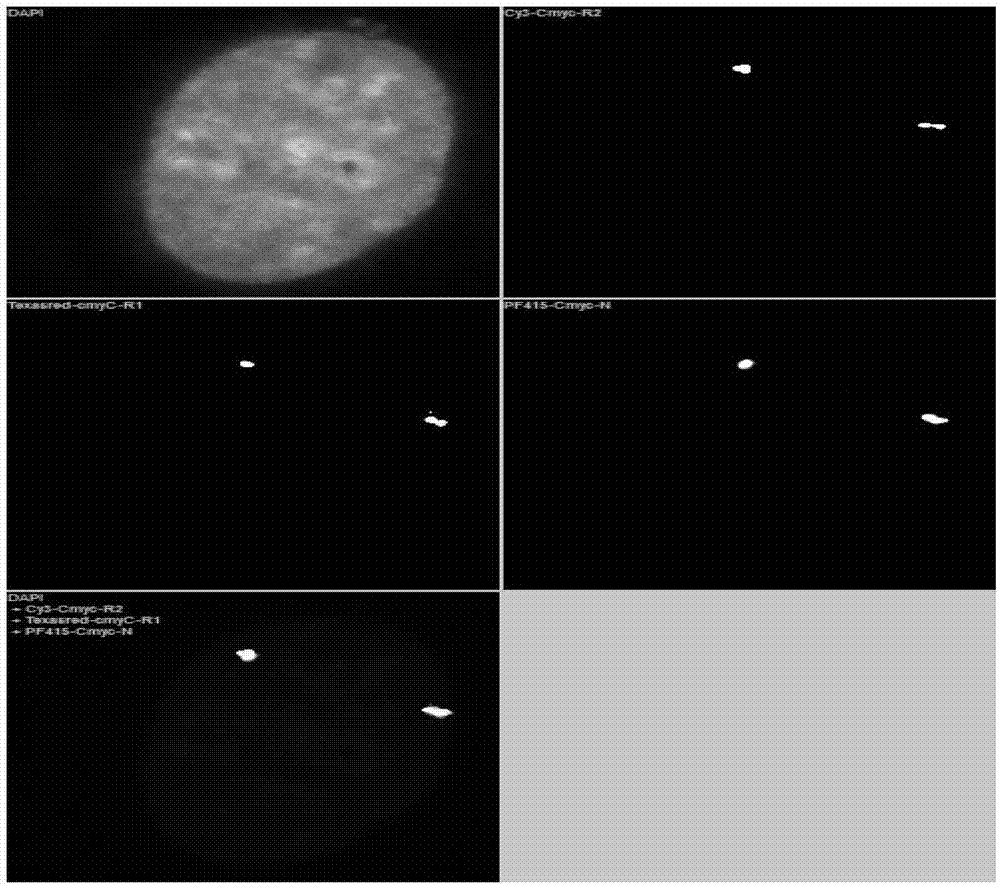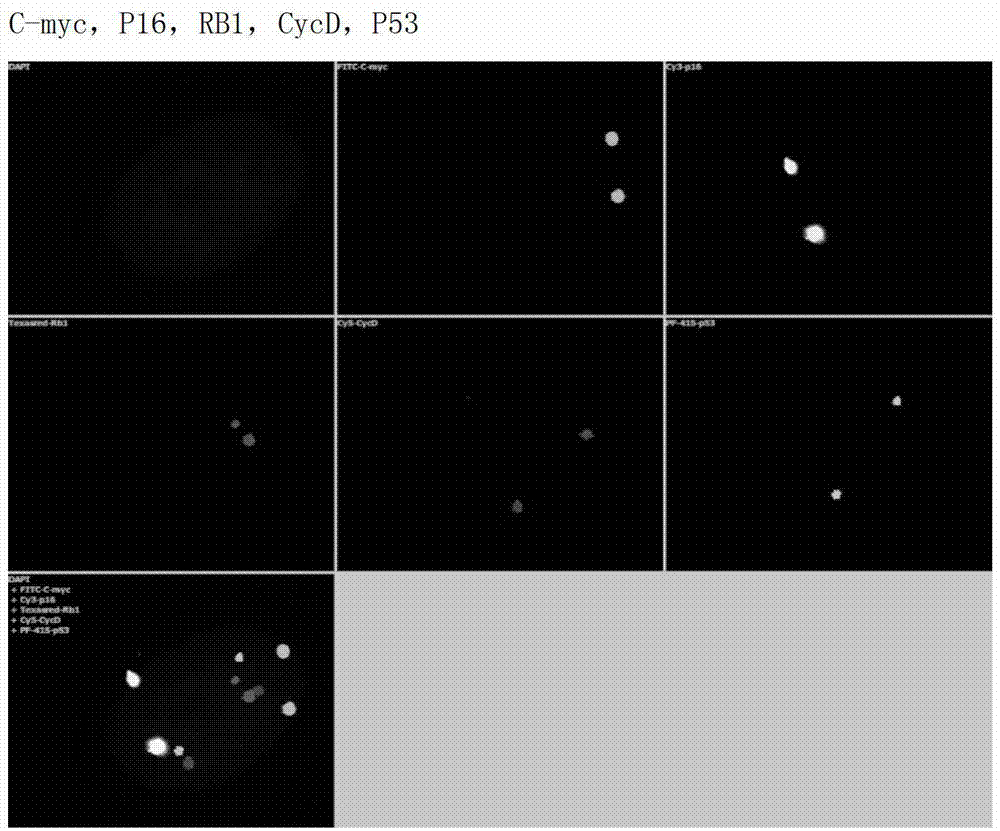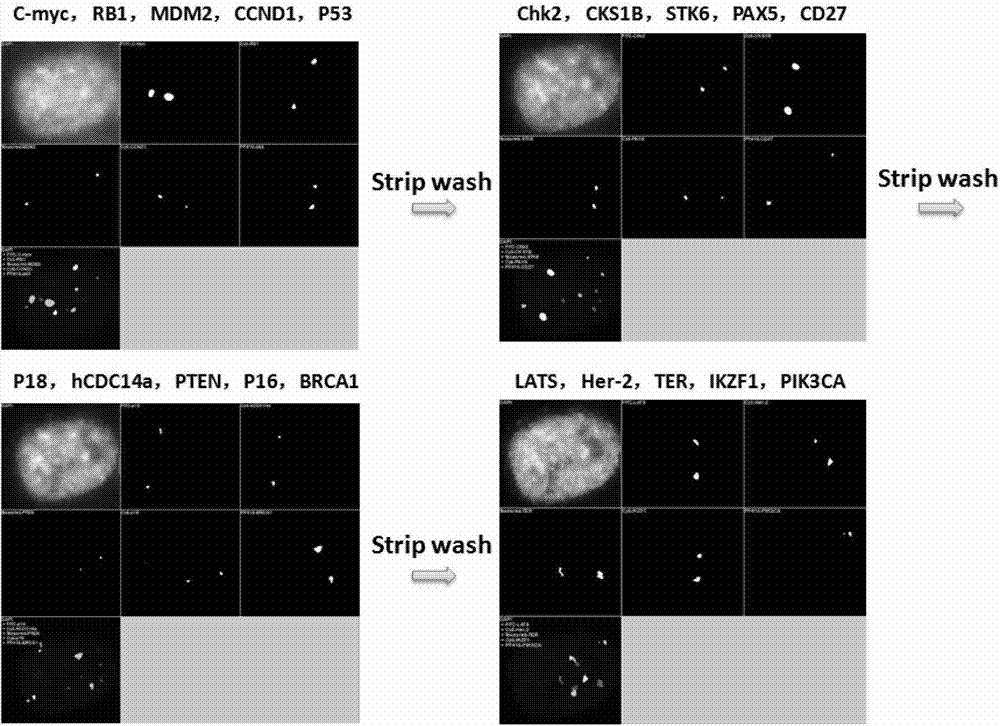Novel high-resolution quantitative multicolor fluorescent in-situ hybridization method and application thereof
A fluorescence in situ hybridization and fluorescein technology, which is applied in the field of new high-resolution multicolor fluorescence inspection, can solve the problem of not being able to observe the changes of multiple related genes in cells at the same time, and achieve the effect of improving signal-to-noise ratio and efficiency
- Summary
- Abstract
- Description
- Claims
- Application Information
AI Technical Summary
Problems solved by technology
Method used
Image
Examples
Embodiment 1
[0032] Embodiment 1: the preparation of C-myc gene probe
[0033] 1. Acquisition of probe DNA
[0034] 1) Streak inoculation: Three BAC strains carrying the C-myc gene were respectively operated according to the following steps. First, the BAC strains were streak-inoculated on an agar plate containing antibiotics (chloramphenicol), and cultured at 37°C. Leave overnight (about 14 hours).
[0035] 2) Initial culture: Pick a monoclonal strain with good growth status the next day, inoculate it in 2ml of LB liquid medium containing antibiotics (chloramphenicol), put it in a shaker at 37°C, set the shaker speed to about 200rpm, and culture 6-8 hours.
[0036] 3) Overnight culture: transfer each 1ml of the bacterial solution obtained in step 2) to 200ml of LB liquid medium containing antibiotics (chloramphenicol), place it on a shaker at 37°C with a rotation speed of 200rpm, and cultivate overnight (about 14-16 hours).
[0037] 4) On the next day, a large amount of DNA was extract...
Embodiment 2
[0080] Example 2: Preparation of Green-C-myc (green), PF555-P16 (yellow), PF590-RB1 (red), HyPer5-CycD ((purple), PF415-P53 (blue) probe combinations
[0081] 1. Acquisition of probe DNA
[0082] 1) Streak inoculation: Streak inoculate BAC strains carrying C-myc, P16, RB1, CycD and P53 genes respectively on agar plates containing antibiotics (chloramphenicol), and culture overnight at 37°C (about 14 Hour).
[0083] 2) Initial culture: Pick a monoclonal strain with good growth status the next day, inoculate it in 2ml of LB liquid medium containing antibiotics (chloramphenicol), put it in a shaker at 37°C, set the shaker speed to about 200rpm, and culture 6-8 hours.
[0084] 3) Overnight culture: transfer each 1ml of the bacterial solution obtained in step 2) to 200ml of LB liquid medium containing antibiotics (chloramphenicol), place it on a shaker at 37°C with a rotation speed of 200rpm, and cultivate overnight (about 14-16 hours).
[0085] 4) On the next day, a large amoun...
Embodiment 3
[0127] Example 3: Detection of 20 genes on the same cell
[0128] 1. Acquisition of probe DNA
[0129] 1) Streak inoculation: Streak inoculate BAC strains carrying 20 genes (Table 3) respectively on agar plates containing antibiotics (chloramphenicol), and culture at 37° C. overnight (about 14 hours).
[0130] 2) Initial culture: Pick a monoclonal strain with good growth status the next day, inoculate it in 2ml of LB liquid medium containing antibiotics (chloramphenicol), put it in a shaker at 37°C, set the shaker speed to about 200rpm, and culture 6-8 hours.
[0131] 3) Overnight culture: transfer each 1ml of the bacterial solution obtained in step 2) to 200ml of LB liquid medium containing antibiotics (chloramphenicol), place it on a shaker at 37°C with a rotation speed of 200rpm, and cultivate overnight (about 14-16 hours).
[0132] 4) On the next day, a large amount of DNA was extracted and purified according to the operating instructions of the QIAGEN plasmid mass extra...
PUM
 Login to View More
Login to View More Abstract
Description
Claims
Application Information
 Login to View More
Login to View More - R&D
- Intellectual Property
- Life Sciences
- Materials
- Tech Scout
- Unparalleled Data Quality
- Higher Quality Content
- 60% Fewer Hallucinations
Browse by: Latest US Patents, China's latest patents, Technical Efficacy Thesaurus, Application Domain, Technology Topic, Popular Technical Reports.
© 2025 PatSnap. All rights reserved.Legal|Privacy policy|Modern Slavery Act Transparency Statement|Sitemap|About US| Contact US: help@patsnap.com



